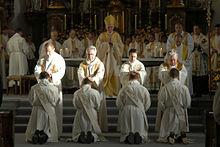Organized religion, also known as institutional religion, is religion in which belief systems and rituals are systematically arranged and formally established, typically by an official doctrine (or dogma), a hierarchical or bureaucratic leadership structure, and a codification of proper and improper behavior.

Definition
editOrganized religion is distinguished from the broader idea of religion especially in anthropology, sociology and philosophy. American philosopher William James considered organized religion to be distinct from and secondary to religion in and of itself, stating that "out of religion in the sense in which we take it, theologies, philosophies, and ecclesiastical organizations may secondarily grow".[1] James further comments that the essential elements of "institutional religion" are "worship and sacrifice, procedures for working on the dispositions of the deity [i.e.] theology, and ceremony and ecclesiastical organization".
Organized religion seems to have gained prevalence since the Neolithic era with the rise of wide-scale civilization and agriculture.[citation needed] Organized religions may include a state's official religion, or state church. However, most political states have any number of organized religions practiced within their jurisdiction. Due to their structured, standardized, and easily proliferated form, organized religions comprise many of the world's major religious groups.[citation needed]
In the modern era, the definition of the term 'religion' is becoming increasingly opaque, making the task of defining 'organized religion' difficult. Anthropologists, theologians and scholars have thus attempted to embed the idea of an 'organization' into the definition of religion itself. Some examples of this are found in the definition provided by Clifford Geertz, who defines religion as a "Cultural system."[2] Furthermore, Max Weber's prominent definition of a religion includes the idea of a 'Church', not necessarily in the Christian formulation, but insisting on the notion of an organized hierarchy constituting a palpable religious body.[3]
Examples and non-examples
editThe Abrahamic religions are all largely considered organized (including Christianity, Islam, Judaism, and the Baháʼí Faith).
Religions that are not organized religions, or only loosely so, include several Eastern religions such as Confucianism,[4] Shinto,[5] some types of Buddhism like Secular Buddhism,[6] and Hinduism in some senses,[7][8] particularly in its lack of a central power structure.[9] The same can be said of most indigenous and folk religions, such as animism,[10] Korean shamanism,[11] African traditions like the San religion,[12] Native American religions,[13] and Old Norse religion,[14] as well as certain new religious movements like modern paganism[15] and Rastafari.[16]
References
edit- ^ James, William (1902). "Lecture II: Circumscription of the Topic". The Varieties of Religious Experience. Arc Manor LLC. pp. 30–31.
- ^ Geertz, Clifford (1966). Religion as a Cultural System. Tavistock.
- ^ Weber, Max (1993). The Sociology of Religion. Beacon Press. ISBN 9780807042052.
- ^ Tu, Wei-Ming (1998). Confucius and Confucianism. Confucianism and the Family, p. 3.
- ^ Josephson, Jason Ānanda (2012). The Invention of Religion in Japan. University of Chicago Press. p. 133. ISBN 0226412342.
- ^ Finley, Wayne (2021). The New Dharma: A Select Bibliography of Secular Buddhism. Journal of Religious & Theological Information, 20(4), 123-137.
- ^ Dasgupta, S. D., & Johnson, A. J. (2015). Hinduism in Brief. Religion and Men's Violence Against Women, 372: "Hinduism is not an organized religion; thus, there is little compulsion of attending a place of worship, worshipping a particular god, reading specific texts, or even declaring oneself as a theist. An atheist can also be a Hindu, as Hinduism is based on lifestyle practices rather than the belief in any particular god/s.... Unlike other religions, the responsibility of priests is quite limited in Hinduism and is mainly confined to condcuting rituals and properly guiding the observant congregation to perform them. Priests do not influence individuals' decision making, offer counsel in crises, or provide emotional support in times of need".
- ^ Bhattacharyya, Harihar (2007). Federalism and competing nations in India. Multinational federations, 1(12), 22-39.
- ^ Kim, Seon Mi, & Balgopal, P. R. (2013). Asian Americans: Overview. Encyclopedia of Social Work.
- ^ Balonon-Rosen, Peter (2013). Out of this world: An ethnographic study of mystics, spirits, and Animist practices in Senegal.
- ^ Baker, Don. (2020). Religious Diversity in Korea. Education About ASIA, 25(1), p. 6.
- ^ Wiebe, Donald (2013). The significance of the natural experience of a “non-natural” world to the question of the origin of religion. Origins of Religion, Cognition and Culture, 140-159.
- ^ McGregor, Sue L. (2004). The nature of transdisciplinary research and practice. Kappa Omicron Nu human sciences working paper series. p. 10.
- ^ Martin, Chandler (2021). Ritual Wear of Nordic Pre-Christian Practices and Early Christian Iceland (Doctoral dissertation).
- ^ Sander, Christensen C. (2017). Ethnic religion in nowadays Europe: renaissance of the historical pagan beliefs or political Paganism? Exemplified by the Asatru in Denmark and the Mari native religion in Russia. Studia Humanitatis, (4), 16.
- ^ Benard, Akeia A. (2019). Narratives of Transfer, Dependence, and Resistance: Rastafarian Perspectives on US Colonialism in the Virgin Islands. Anthropology of consciousness, 30(2), 117-131.